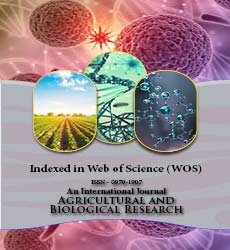Agricultural and Biological Research
RNI # 24/103/2012-R1
Oyeyemi A Dada*, Funso R Kutu and Sydney Mavengahama
Appropriate plant spacing is vital to maximizing marginal field and expediting equitable distribution of applied plant nutrients for improved popcorn yield. Two field experiments were carried out during summer seasons of 2017/18 and 2018/19 at the North-West University (NWU) research farm, Mafikeng campus. The study investigated response of popcorn to different rates of compost and NPK 20-7-3 fertilizer and plant spacings in semi-arid region of South Africa. The trial consisted of twenty treatments laid out as a split plot in randomized complete block design (R=3). The main plot and subplot effects were amendment rates (4 and 8 t/ha compost, 90 and 180 kg N/ha, while unamended field served as the control); and four intra row spacings (cm): 15 × 15 (SP1), 20 × 20 (SP2), 25 × 25 (SP3) and 30 × 30 (SP4). Data were collected on growth and yield components. Popcorn had highest number of leaves (12.75) in plots fertilized with 8 t/ha compost under SP4, while tallest plant (205.64 cm) was recorded in plots intra spaced at SP2 and fertilized with 8 t/ha compost.
Leaf area index was highest (5.1) in plots amended with 90 kg/ha NPK under SP4. The chlorophyll content of popcorn in plots supplied 90 kg/ha NPK under SP3 was significantly higher with 56.1% more than leaf chlorophyll from unfertilized plots under SP1. Biomass (178.33 g/plant) and ear number (2.08) where highest in plots treated with 180 kg/ha NPK under SP3. Kernel yield of 3.28 t/ha and harvest index of 0.32 were lowest in unfertilized plots under SP1. Popcorn yield improved in plots amended with 8 t/ha compost at SP2 plant spacing similar to the observations in field fertilized with 90 kg N/ha mineral fertilizer. Nevertheless, the provision of balanced nutrients from and the eco-friendliness of applying organic fertilizer favours the preference for the use of compost for promoting increased popcorn production.
